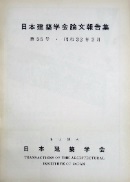284 巻
選択された号の論文の23件中1~23を表示しています
- |<
- <
- 1
- >
- >|
-
原稿種別: 表紙
1979 年284 巻 p. Cover1-
発行日: 1979/10/30
公開日: 2017/08/22
PDF形式でダウンロード (80K) -
原稿種別: 表紙
1979 年284 巻 p. Cover2-
発行日: 1979/10/30
公開日: 2017/08/22
PDF形式でダウンロード (80K) -
原稿種別: 付録等
1979 年284 巻 p. App1-
発行日: 1979/10/30
公開日: 2017/08/22
PDF形式でダウンロード (42K) -
原稿種別: 目次
1979 年284 巻 p. Toc1-
発行日: 1979/10/30
公開日: 2017/08/22
PDF形式でダウンロード (90K) -
原稿種別: 付録等
1979 年284 巻 p. App2-
発行日: 1979/10/30
公開日: 2017/08/22
PDF形式でダウンロード (31K) -
原稿種別: 本文
1979 年284 巻 p. 1-8
発行日: 1979/10/30
公開日: 2017/08/22
PDF形式でダウンロード (1020K) -
原稿種別: 文献目録等
1979 年284 巻 p. 8-
発行日: 1979/10/30
公開日: 2017/08/22
PDF形式でダウンロード (48K) -
原稿種別: 本文
1979 年284 巻 p. 9-15
発行日: 1979/10/30
公開日: 2017/08/22
PDF形式でダウンロード (1116K) -
原稿種別: 本文
1979 年284 巻 p. 17-27
発行日: 1979/10/30
公開日: 2017/08/22
PDF形式でダウンロード (1458K) -
原稿種別: 本文
1979 年284 巻 p. 29-39
発行日: 1979/10/30
公開日: 2017/08/22
PDF形式でダウンロード (1328K) -
原稿種別: 本文
1979 年284 巻 p. 41-50
発行日: 1979/10/30
公開日: 2017/08/22
PDF形式でダウンロード (899K) -
原稿種別: 本文
1979 年284 巻 p. 51-60
発行日: 1979/10/30
公開日: 2017/08/22
PDF形式でダウンロード (1010K) -
原稿種別: 本文
1979 年284 巻 p. 61-68
発行日: 1979/10/30
公開日: 2017/08/22
PDF形式でダウンロード (929K) -
原稿種別: 本文
1979 年284 巻 p. 69-77
発行日: 1979/10/30
公開日: 2017/08/22
PDF形式でダウンロード (1045K) -
原稿種別: 本文
1979 年284 巻 p. 79-84
発行日: 1979/10/30
公開日: 2017/08/22
PDF形式でダウンロード (722K) -
原稿種別: 本文
1979 年284 巻 p. 85-91
発行日: 1979/10/30
公開日: 2017/08/22
PDF形式でダウンロード (765K) -
原稿種別: 本文
1979 年284 巻 p. 93-99
発行日: 1979/10/30
公開日: 2017/08/22
PDF形式でダウンロード (881K) -
原稿種別: 本文
1979 年284 巻 p. 101-110
発行日: 1979/10/30
公開日: 2017/08/22
PDF形式でダウンロード (1302K) -
原稿種別: 本文
1979 年284 巻 p. 111-117
発行日: 1979/10/30
公開日: 2017/08/22
PDF形式でダウンロード (896K) -
原稿種別: 本文
1979 年284 巻 p. 119-125
発行日: 1979/10/30
公開日: 2017/08/22
PDF形式でダウンロード (753K) -
原稿種別: 本文
1979 年284 巻 p. 127-137
発行日: 1979/10/30
公開日: 2017/08/22
PDF形式でダウンロード (1094K) -
原稿種別: 本文
1979 年284 巻 p. 139-148
発行日: 1979/10/30
公開日: 2017/08/22
PDF形式でダウンロード (1660K) -
原稿種別: 本文
1979 年284 巻 p. 149-158
発行日: 1979/10/30
公開日: 2017/08/22
PDF形式でダウンロード (1207K)
- |<
- <
- 1
- >
- >|
